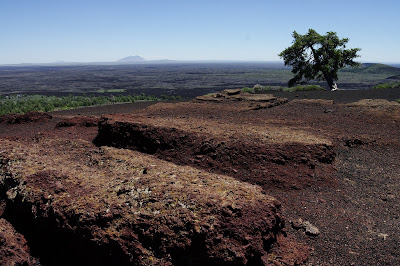(Day of June 23rd)
We
ate breakfast at the
hotel (biscuits and gravy and breakfast sausage! Hooray for calories!),
finished our wifi time, and set out north for Craters of the Moon
National Park. We
drove through open fields, and then...BASALT! The grassland suddenly
gave way to a desolate black basalt field, with virtually no vegetation.
[Elizabeth sidebar] Craters of the Moon is so named because when people
first started exploring it, they thought "this is a really crazy
landscape. The moon has volcanism. I bet it is what the surface of the
moon looks like." And hence, the name. [end sidebar]
Fun
geology facts about Craters of the Moon: The volcanism at Craters of
the Moon is due to a hotspot, not subduction, unlike the nearby Columbia
River Flood Basalts. It is mostly rhyolite with a thin layer of basalt
on top. There is currently no active volcanism, but this formation is
relatively recent-- the most recent lava flow is 2,000 years old. It
looks it, too, since in many cases there is very little plant growth.
[Elizabeth sidebar] You could definitely tell both how much younger or
older certain sections and flows were based on how many plants there
were, and also where the flows stopped because of where plants weren't.
It was really spectacular. Some of these young eruptions probably
occurred when Native people were in the area, and it would be
fascinating to hear what (if anything) made it into the oral histories
of the native tribes. I am torn as to whether I'd want to have been
around to see it, or would not want to be anywhere near the area... [end
sidebar]
At the visitor center, we talked to a nice ranger who told us three useful things:
(1) Grab campsite 13 because it's the most sheltered from the wind;
(2) Go up the cinder cone.
(3) Go see the lava tubes.
We did all three of these things!
First,
we grabbed campsite 13. This was crucial because it was VERY, VERY
WINDY. It was a circular hole in chest-high lava flows with a narrow
passageway in. So cool. [Elizabeth sidebar - and soooo much less windy!]
Second,
we climbed the cinder cone. IT
WAS SO WINDY. SO WINDY. SOOOO VERY WINDY. This was the most forceful
wind I've ever experienced. It was so windy I had to set my camera to
ISO 400 in bright daylight so that the pictures wouldn't be blurred by
the wind shaking my hands. It was so windy I had trouble breathing. It
was so windy that at some points I had to sit down so that the wind
didn't blow me over. IT WAS SO WINDY. [Elizabeth sidebar - it was so
windy that gusts of wind actually hurt. It felt like downhill skiing in
uphill wind. It was fun, but oh, so windy]
But the view was great.
And
there was actually a tree growing at the top of the cinder cone in a
relative wind shadow. [Elizabeth sidebar - thanks random grasses that
somehow grew on the top of the mountain]
We visited a couple other cinder cones, then went on to the lava tubes.
Before
the lava tubes, here is a lesson in basalt flows. There are two types
of basalt flows, produced by basalt of different viscosity due to
differing amounts of water in the lava.
Pahoehoe has relatively
large amounts of water, flows smoothly, and makes a smooth, wrinkly
crust. Lava tubes can form in pahoehoe as the lava cools and a crust
forms on the surface, but lava keeps flowing beneath. This is what
makes lava tubes.
Aa has relatively low
amounts of water, is very viscous, and forms a crackled, broken crust.
Very nasty to try to walk on. [The Hawaiians will tell you that "aa",
pronounced "ah-ah", is the noise you make if you walk on it]
Some
of the lava tubes were small and somewhat dangerous to explore, but one
of them was several stories tall. [Elizabeth sidebar: there were
several which you could crawl into if you had a trusty headlamp.
Unfortunately we had only one trusty headlamp, and it seems that groups
of 4-8 are optimally sized for adequately lighting the caves...
Apparently the cave called "Boy Scout Cave" is the one to go to - it's a
~500 foot tunnel that ends with icicles! Unfortunately we just had to
enjoy pictures, since there weren't enough of us to safely explore the
cave.]
In several locales around the
park, there were sparse flowers blooming across the black soil. So
beautiful. [Elizabeth sidebar: some of these flowers were a species that
only blooms for a few weeks in mid-June: we picked exactly the right
time to visit!]
[Elizabeth sidebar] We
set up the tent in the not-so-windy circle of rocks at Campsite 13
(lucky 13), and had to be pretty careful about the wind - it kept
blowing around everything, so we quickly put it up and put heavy bags in
it to help hold it down. We shouldn't have worried, though: with the
setting of the sun, the wind disappeared. [end sidebar]
We had an early night in order to wake up early for the next day's adventure-- Yellowstone! And Grand Teton National Park!








No comments:
Post a Comment